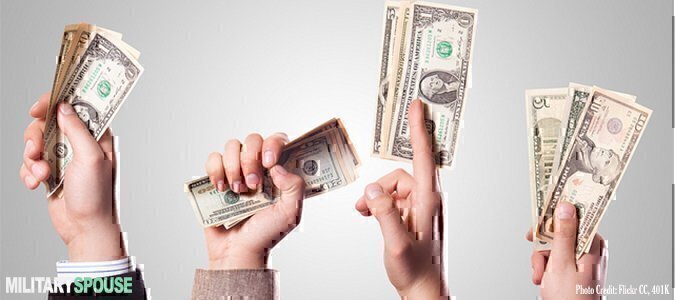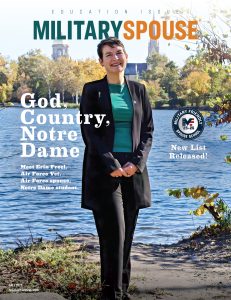According to a recent survey done by SunTrust, a quarter of American households earning more than $100,000 a year are living paycheck-to-paycheck. Americans are struggling to save their money and income level can’t be the only thing to blame. We also need to take a closer look at our spending habits.
My husband and I got married right before we moved overseas to our first duty station. At our wedding, a friend told us a story of a service member he knew that was able to save enough money during his overseas assignment to buy a house with cash when he returned. We had a little bit of money saved at the time, but I figured it would be impossible to save that much! I do, however, love a good challenge.
We decided to save as much as we could while still taking advantage of the really cool place we were living in. After living overseas for nearly 4 years, we returned stateside last summer and I can proudly say that we did it!
Before you get too excited, let me explain. We don’t have enough cash to buy a house or even a condo in California, but we did save enough money to buy a modest 3-bedroom/2-bathroom home in small town USA.
It took a fair amount of planning and self-discipline, but this is how we did it:
- We Lived BELOW our Means
People often say to live within your means, but has anyone ever told you to live below your means? I don’t mean that you should live like a college student and only eat ramen for dinner, but find a comfortable cost of living that is actually below what you can afford.
Let me give you a few examples.
- When we moved overseas, most of our friends found housing that cost exactly their OHA (Overseas Housing Allowance) or even a decent amount above. Many of them justified the payments they would be making out of pocket for the nice homes they would be living in. My husband and I instead found an apartment that was well below our OHA. Now before you start to think how awful this sounds, I will tell you that our sweet, little apartment was oceanfront with unbelievable views. It was just small and a little run down. While we were not able to keep the difference in OHA that we saved the government, it did set us up for successful, frugal living. Our utility bills were quite a bit less than our counterparts in the nice, large homes. Each month we were given a separate allowance for utilities and whatever we didn’t use was ours to keep. Just by using the air less, we were able to have an extra, steady income.
- Putt-Putt. This is the name that we gave my car overseas. We originally purchased it for $1000 on the Lemon Lot with the intention of selling it after we found a nicer car. It was small and beat up, but extremely reliable. After some time, we decided that we didn’t need anything fancier. It wasn’t the most beautiful, brag-worthy vehicle, but it did the job. We were known around town for driving the old beater while others drove BMWs. My car lasted wonderfully all 4 years of our assignment.
- For the first 10 months or so while I was looking for employment, we got used to living under one paycheck. When we finally had a second source of income, we redirected my paycheck to a separate bank account that we did not touch. Because we had grown accustomed to the single paycheck cost of living, we didn’t feel like we were sacrificing anything by saving all of my income. This also works well for promotions and military pay increases. If you are comfortable where you are, consider increasing your cost of living by only 10% with each pay increase and putting the rest into savings.
- One word: COLA. This stands for the Cost of Living Allowance that is given to service members stateside or overseas that live in an unusually expensive location. Where we were stationed, COLA was a substantial amount of money each month. While living under a budget, we were able to save the majority of our COLA. We still enjoyed the local community, went to festivals and ate the local cuisine, but we kept an eye on our spending and lived below our means. There are some expenses that are unavoidable that COLA does help offset, like road tax and specific city trash bags for example.
The biggest struggle that I have seen friends and clients deal with is getting too used to their way of life with the extra allowances and extra income. With all of this additional money that we were receiving overseas, many people still chose to live above their means. They returned to the States with a big financial slap to the face.
- We Made a Budget
Figuring out how to create extra income streams is only half of the equation. The other half is learning how to manage that extra money. The best way to create a budget is to first track where your money is going. Track your expenses for anywhere from 7 – 30 days and then put together a basic budget. There are many tools you can use to create a budget – you can use excel, a template (like the one found here), or just a pen and paper.
Keep in mind that your budget won’t be perfect your first try. You will most likely overestimate your expenses in a specific category and underestimate your expenses in another category. Make adjustments to your budget each month until you have a good, working budget. It may take 3 solid months before you have an accurate budget.
Once you have a budget that is good to go, start trying to find places where you can cut corners. Can you reduce the number of times that you eat out each month? How about trying to meal plan to lower your grocery bill? Do you really need 100+ television channels? Try to find a way to lower your expenses without sacrificing your way of life too much. You will be surprised with how much you can save by cutting out all of the small, unnecessary purchases.
- We Created Good Habits
Now that you have a budget put together, it’s time to come up with a process for staying true to it. A budget is only useful so long as you actually use it. You can choose from a number of budgeting apps that will categorize your expenses for you and automatically track your spending. They will even send you a notification when you’re getting close to your monthly limit in a particular category. I’ve personally found that the apps work well once you’ve already established good habits. There is really nothing holding you to those numbers except will power.
To develop these good habits, my husband and I took the extreme approach by using Dave Ramsey’s idea of cash envelopes. With each paycheck, I withdrew enough cash to last us until our next paycheck. I made my own envelopes using cardstock and placed them in a three-ring planner. The theory behind the cash envelope system is that consumers have a harder time making purchases when they physically hand over cash than when they swipe a card. You also constantly have a visual reminder of how much money is left in each envelope. As you watch that money dwindle away, you tend to make more and more conservative purchases.
We stayed on the cash envelope system for just over a year – until I was confident that the principles behind it were drilled into our minds. We now swipe our debit cards cautiously and are much more aware of our spending patterns. If I ever feel like we are falling behind again, I whip out our envelopes for a little while as a reminder.
- We Made a Separate Account for Each Goal
This day in age, it’s not difficult to find banks that offer free checking or savings accounts. To simplify our budget, I created a separate account for each of our goals. For the short-term goals (less than a year), I use different checking accounts. An example of this would be our travel fund. We transfer money into our travel fund each month and then use that specific debit card when we are traveling. I try to get ahead of the game and once the current year’s travel account is fully funded, I start putting money for the following year’s travel adventures into a CD (Certificate of Deposit). This way the money is locked in until I need it and actually earns a little bit of interest. So any goal that expands out further than a year (saving for a car, saving for my son’s college, saving for retirement, etc.) I put into an interest-bearing savings account or I invest it. The sooner you’ll need the money, the easier the access you’ll want to the money.
One benefit to having separate accounts for each goal is that you are far less likely to “borrow” money from a goal and set back your progress. It also makes it very easy to automatically transfer money into each goal account directly from your paycheck, so you won’t even see it. This is where the saying “pay yourself first” comes from. If you set up automatic transfers into your savings account at the beginning of the month, chances are you’ll figure out how to pay the rest of your expenses with the remaining funds. If you pay all of your expenses first and plan to transfer money into your savings accounts at the end of the month, there usually ends up being significantly less money to transfer.
My husband and I have been made fun of plenty along the way for our frugal way of life. The envelope system, especially, brought up laughter and jokes. We’ve managed to take pride in the whole process and we usually get the last laugh. We have financial freedom that not many of our friends can relate to. We’ve backpacked through Southeast Asia with cash. We bought my car this past summer with cash. And yes, we even put an offer in on a house with CASH. Neither my husband nor I feel like we have really had to sacrifice to get to this point. We live adventurous lives and love to explore, all with cash.
For more money tips from Alex, check out Military Planners.




